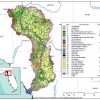Abstract
Land-use decisions and ecosystem characteristics affect the amounts of nutrients that end up in water bodies and the ability of the land to provide ecosystem services. Water quality is also highly valued by Florida forest landowners and managers. So, understanding the role of land use and forest cover and types, management practices, and conservation programs in reducing nutrient pollution will allow landowners, forest managers, and policy makers to make informed and better management decisions. In this 6-page fact sheet, we present the results of a study that used easily available models and information to assess the role of forests in providing ecosystem services, including water quality improvement or purification. Specifically, this assessment used available geospatial data and the InVEST Water Purification model to estimate how forest vegetation and soils purify water through the retention, and subsequent export, of nitrogen and phosphorus polluted runoff. Written by Sonia Delphin, Francisco J. Escobedo, Amr Abd-Elrahman, Alison E. Adams, Jackie Martin, Ronald Cademus, and published by the UF Department of School of Forest Resources and Conservation, January 2014.
References
Agyin-Birikorang, S., G. A. O'Connor, and T. A. Obreza. 2009. "Drinking Water Treatment Residuals to Control Phosphorus in Soils." University of Florida EDIS Publication SL300 http://edis.ifas.ufl.edu/ss513. https://doi.org/10.32473/edis-ss513-2009
Conte, M., D. Ennaanay, G. Mendoza, M. Walter, S. Wolny, D. Freyberg, E. Nelson, and L. Solorzano. 2011. "Retention of nutrients and sediment by vegetation." In P. Kareiva, H. Tallis, T. H. Ricketts, G.C. Daily, S. Polasky (Ed.), Natural Capital Project: Theory and Practice of Mapping Ecosystem Services, Oxford University Press. pp. 89-110. https://doi.org/10.1093/acprof:oso/9780199588992.003.0006
Escobedo F. J., and N. Timilsina (Editors). 2012. Stewardship Ecosystem Services Survey Project. Gainesville, FL: University of Florida. Available at http://www.sfrc.ufl.edu/cfeor/SESS.html. (accessed October 1, 2012).
Florida Forest Service. 2008. Silviculture Best Management Practices Manual. http://www.floridaforestservice.com/publications/silvicultural_bmp_manual.pdf (accessed October 1, 2012).
Georgia Department of Natural Resources. 1998. Coosa River Basin: Management Plan. http://www.gaepd.org/Documents/coosa_plan.html (accessed January, 2012).
Georgia Department of Natural Resources. 2002. Suwannee River Basin: Management Plan 2002. http://www.gaepd.org/Files_PDF/plans/suwannee/suwannee.pdf. (accessed January, 2012).
German, E. R. 1997. Analysis of non-point source groundwater contamination in relation to land use: Assessment of non-point source contamination in central Florida. US Geological Survey Water-Supply Paper 2381-F. 65p.
Hallas, J. F., and W. Magley. 2008. Nutrient and dissolved oxygen TMDL for the Suwannee River, Santa Fe River, Manatee Springs (3422R), Fanning Springs (3422S), Branford Spring (3422J), Ruth Spring (3422L), Troy Spring (3422T), Royal Spring (3422U), and Falmouth Spring (3422Z). Florida Department of Environmental Protection, Division of Water Resource Management, Bureau of Watershed Management. 117 p.
Katz, B. G., R. S. DeHan, J. J. Hirten, and J. S. Catches. 1997. "Interactions between ground water and surface water in the Suwannee River Basin, Florida." Journal of the American Water Resources Association, 33:1237-1254. https://doi.org/10.1111/j.1752-1688.1997.tb03549.x
Kreye, M., F. J. Escobedo, D. C. Adams, T. Stein, and T. Borisova. 2013. "Valuing the Ecosystem Services of Florida's Forest Conservation Programs: The Economic Benefits of Protecting Water Quality." University of Florida- IFAS, EDIS, FOR 309 https://edis.ifas.ufl.edu/fr377 https://doi.org/10.32473/edis-fr377-2013
Light, H. M., M. R. Darst, and L. J. Lewis. 2002. Hydrology, vegetation, and soils of riverine and tidal floodplain forests of the Lower Suwannee River, Florida, and potential impacts of flow reductions. U.S. Geological Survey Professional Paper, 1656a. 124 p. https://doi.org/10.3133/pp1656A
Mendoza, G., D. Ennaanay, M. Conte, T. M. Walter, D. Freyberg, S. Wolny, L. Hay, S. White, E. Nelson, and L. Solorzano. 2011. "Water supply as an ecosystem service for hydropower and irrigation." In P. Kareiva, H. Tallis, T. H. Ricketts, G.C. Daily, S. Polasky (Ed.), Natural Capital Project: Theory and Practice of Mapping Ecosystem Services. Oxford: Oxford University Press. pp. 89-110. https://doi.org/10.1093/acprof:oso/9780199588992.003.0004
Nesheim, O. N., and F. M. Fishel. 2009. "Protecting Water Resources from Agricultural Pesticides." University of Florida EDIS Publication PI1, http://edis.ifas.ufl.edu/pi001(accessed July, 2012). https://doi.org/10.32473/edis-pi001-2009
Stein, T., N. Kil, A. Frank, A. E. Adams, D. C. Adams, and F. J. Escobedo. 2013. "Public Land Management Agencies' and Nonindustrial Private Forest Landowners' Perceptions about Ecosystem Services." University of Florida- IFAS, EDIS, FOR 312 https://edis.ifas.ufl.edu/fr312 https://doi.org/10.32473/edis-fr380-2013
Stets, E. G., V. J. Kelly, W. P. Broussad, III, T. E. Smith, and C. G. Crawford, C.G. 2012. Century-scale perspective on water quality in selected river basins of the conterminous United States. U.S. Geological Survey Scientific Investigations Report 2012-5225, 108 p. https://doi.org/10.3133/sir20125225
Trepanier, C., S. Parent, Y. Comeau, J. Bouvrette. 2002. "Phosphorus budget as a water quality management tool for closed aquatic mesocosms." Water Research 36(4): 1007-1017. https://doi.org/10.1016/S0043-1354(01)00286-X

